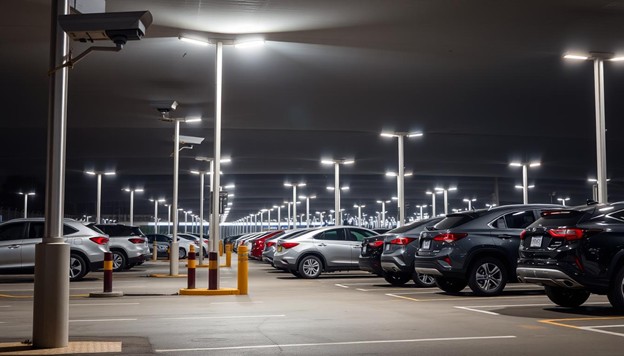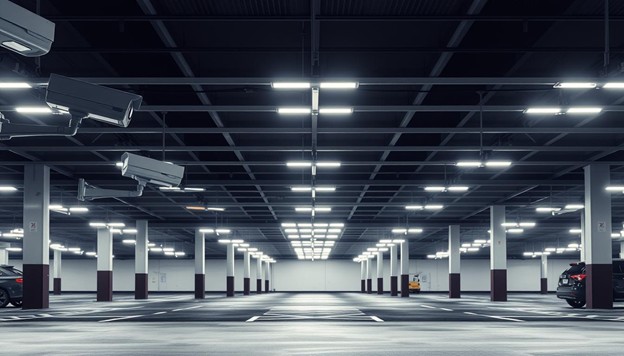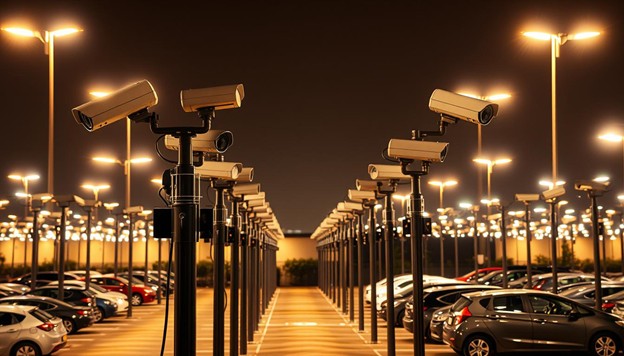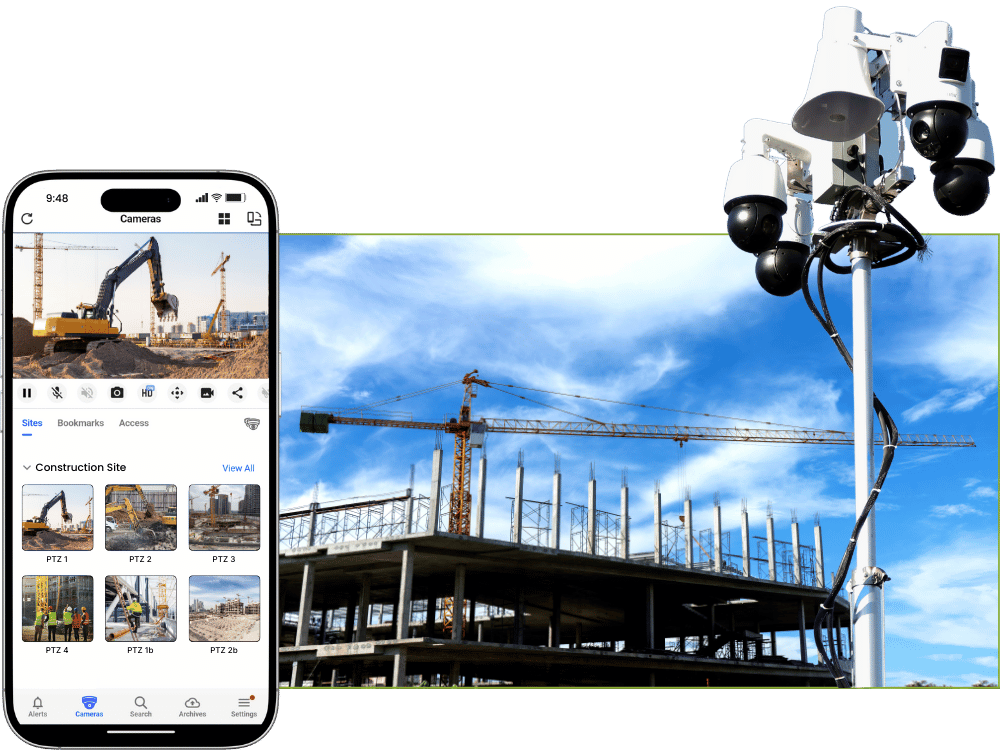Keeping your parking lot secure is key for businesses. It protects your assets and lowers your liability. A safe parking area also makes your business look better.
Effective security measures can greatly lower the chance of security problems. This article will show you seven ways to make your parking area safer. This will create a safer place for everyone.
 Commercial parking areas face many security threats like theft, vandalism, and assault. These can happen because of poor lighting, no surveillance, or not enough security staff. Knowing these threats helps in setting up good security.
Commercial parking areas face many security threats like theft, vandalism, and assault. These can happen because of poor lighting, no surveillance, or not enough security staff. Knowing these threats helps in setting up good security.

 To boost parking lot security, a full CCTV system is key. These systems scare off criminals and help solve crimes.
To boost parking lot security, a full CCTV system is key. These systems scare off criminals and help solve crimes.
 It’s key to manage who comes and goes in a parking lot. Good parking lot access control systems cut down on unauthorized entry. This boosts the lot’s security.
It’s key to manage who comes and goes in a parking lot. Good parking lot access control systems cut down on unauthorized entry. This boosts the lot’s security.
By making upkeep and safety checks a part of their security plan, property owners can make their parking lots safer. This not only lowers legal risks but also makes the area safer for everyone.
Key Takeaways
- Enhance lighting in parking areas
- Install CCTV cameras for surveillance
- Implement access control measures
- Increase security personnel presence
- Conduct regular security audits
The Critical Role of Parking Lot Security in Business Protection
Parking lot security is key to protecting businesses from threats and liabilities. A secure parking area keeps customers and employees safe. It also lowers the chance of financial loss from theft, vandalism, or crime.Common Security Threats in Commercial Parking Areas

Understanding Your Legal Liability as a Property Owner
As a property owner, you must ensure your parking lot is safe. Not having enough security can lead to legal trouble if something happens. It’s important to know your duties and take steps to reduce risks.The Financial Impact of Security Incidents
Security issues in parking lots can cost a lot, including damage, lawsuits, and lost business. Good security can lower these risks and keep your business profitable.| Security Measure | Cost | Benefit |
| Improved Lighting | $5,000 | Reduced crime rate, increased safety |
| CCTV Surveillance | $10,000 | Enhanced security, deterrent to crime |
| Security Personnel | $20,000/year | Active security presence, rapid response |
1. Enhancing Parking Lot Lighting Systems
Improving parking lot lighting is a key step to boost security. Good lighting can stop crime, cut down on accidents, and make the area safer. A well-lit parking lot is not just safer but also more welcoming to visitors.
Selecting the Right Lighting Fixtures
Choosing the right lighting is crucial for good parking lot lighting. Different spots need different lights. For big areas, LED lights are great because they save energy and light up well.Strategic Placement for Maximum Coverage
Where you put the lights is key to covering the area well. Lights should fill in dark spots and shadows where bad things could hide. Even lighting makes the whole area brighter and safer.| Lighting Fixture Type | Area Suitability | Energy Efficiency |
| LED Lights | Large Parking Areas | High |
| Sodium Vapor Lights | Medium-sized Lots | Medium |
| Solar-Powered Lights | Small Lots or Pathways | High |
Implementing Regular Maintenance Schedules
Keeping the lights in good shape is important. This means cleaning them, replacing bulbs, and checking for damage. A maintenance schedule keeps the lights working and the area secure.Energy-Efficient Options for Sustainable Security
Choosing energy-saving lights cuts costs and is good for the planet. LED lights and solar-powered lights are top picks for saving energy and keeping things safe.2. Installing Comprehensive CCTV Surveillance Systems
 To boost parking lot security, a full CCTV system is key. These systems scare off criminals and help solve crimes.
To boost parking lot security, a full CCTV system is key. These systems scare off criminals and help solve crimes.
Camera Types and Their Specific Applications
There are many camera types for parking lots. Dome cameras work indoors and outdoors. bullet cameras are seen from far away. PTZ (Pan-Tilt-Zoom) cameras can be moved and zoomed in remotely.Optimal Camera Placement for Complete Coverage
Where you put cameras matters a lot. Place them at entrances, exits, and key spots. Make sure they’re high up and angled right to avoid tampering and see clearly.Video Storage Solutions and Retention Policies
Good video storage and rules are key for legal and crime solving. Use Network Video Recorders (NVRs) and Digital Video Recorders (DVRs) for storing. Keep footage long enough to solve cases fully.Remote Monitoring Options and Integration
Watching live feeds remotely helps respond fast to problems. Today’s CCTV systems can link with security software. This lets you watch and get alerts on phones or computers.| Feature | Benefit | Implementation |
| Camera Types | Varied surveillance capabilities | Select based on area requirements |
| Optimal Placement | Comprehensive coverage | Strategic installation at entrances/exits |
| Video Storage | Secure footage retention | NVR/DVR systems |
| Remote Monitoring | Real-time incident response | Integration with security software |
3. Implementing Effective Access Control Measures
 It’s key to manage who comes and goes in a parking lot. Good parking lot access control systems cut down on unauthorized entry. This boosts the lot’s security.
It’s key to manage who comes and goes in a parking lot. Good parking lot access control systems cut down on unauthorized entry. This boosts the lot’s security.
Gate and Barrier Systems for Vehicle Management
Gates and barriers are vital for access control. They can be automated or manual. They help control who comes in and out. This lowers the chance of unwanted visitors.Card Access and Digital Authentication Solutions
Card access and digital authentication add more security. They use cards or digital IDs to check who’s entering. This makes sure only the right people get in.Visitor Management Protocols
Managing visitors is crucial. Protocols include registration, visitor badges, and escort rules. Good visitor management keeps everyone safe.Integration with Existing Security Infrastructure
Linking access control with CCTV and alarms makes a strong security network. This setup lets for quick monitoring and action. It makes the parking lot safer. Using these access control steps can greatly improve parking lot security. It’s important to pick the right solutions for each lot’s needs.4. Hiring Professional Parking Lot Security Personnel
To make parking lots safer, having well-trained security staff is key. Hiring pros is a smart move to boost parking lot safety.Benefits of Trained On-Site Security Guards
Having trained security guards brings many advantages, including:- Deterrent Effect: Seeing guards can scare off bad guys.
- Rapid Response: They can act fast to stop problems.
- Enhanced Customer Safety: People feel safer with guards around.
Security Staff Training Requirements and Certifications
Security staff need good training to do their job well. This includes:- Learning basic security rules and how to handle emergencies.
- Getting trained in first aid and CPR.
- Having certifications from trusted security training programs.
Developing Effective Patrol Schedules and Coverage
It’s important to plan out patrol schedules well. This means:- Finding out where and when trouble is most likely to happen.
- Putting guards in the right places to watch over everything.
- Checking and changing patrol plans as needed.
Cost-Benefit Analysis and Liability Reduction
Hiring security staff costs money, but it’s often worth it. A careful look at costs and benefits shows:- Less chance of getting sued because of better security.
- Fewer crimes and less money spent on them.
- Happier customers who come back more often.
5. Conducting Regular Maintenance and Safety Inspections
Keeping a parking area safe needs regular checks. It’s key to have a solid plan for upkeep and safety checks. This way, owners can spot and fix problems early, cutting down on risks and boosting security.Creating a Comprehensive Maintenance Checklist
Having a detailed checklist is crucial. It helps make sure everything in the parking lot is checked often. This includes lights, signs, the pavement, and security gear. Regular checks help find and fix issues before they get worse.Identifying and Addressing Potential Hazards
Regular checks help spot dangers like bad lighting or broken cameras. Fixing these problems fast is key to keeping things safe. This not only makes the area more secure but also shows you care about safety, which helps in legal disputes.Documentation Practices for Liability Protection
Keeping detailed records of upkeep and safety checks is important for legal protection. These records show you’ve done your best to keep the area safe. It’s crucial to document all inspections, repairs, and safety talks.Seasonal Maintenance Requirements
Each season brings its own upkeep needs. For example, winter needs snow removal, and summer needs to keep plants in check. Knowing these needs helps keep the area safe all year.| Season | Maintenance Task | Security Implication |
| Winter | Snow removal, de-icing | Ensures clear paths and visibility |
| Summer | Vegetation management | Maintains clear lines of sight |
| All Year | Lighting inspection | Ensures adequate illumination |
6. Installing Emergency Response and Safety Devices
Installing emergency response and safety devices is key for safe parking. These devices boost parking safety and offer quick help in emergencies.Emergency Call Stations: Selection and Strategic Placement
Emergency call stations let users quickly reach out to security or police. It’s important to pick durable, easy-to-see, and simple-to-use stations. Place them well in the parking area for easy access in emergencies.Panic Buttons and Alert Systems Implementation
Panic buttons and alert systems add more security. They can go near parking attendants or in security offices. Setting them up needs careful planning to fit with current security systems.Fire Safety Equipment Requirements and Placement
Fire safety gear like fire extinguishers and smoke detectors are vital. They help stop and handle fires. Place them as local fire laws say, making sure they’re easy to get to.ADA Compliance and Accessibility Considerations
It’s important that emergency devices follow ADA rules for everyone’s safety. This means they must be easy for people with disabilities to use and reach.| Safety Device | Purpose | ADA Compliance Consideration |
| Emergency Call Stations | Quick contact with security or law enforcement | Height and accessibility for wheelchair users |
| Panic Buttons | Alerting security personnel in emergencies | Clear signage and tactile buttons |
| Fire Extinguishers | Mitigating fires | Accessible mounting height and clear signage |

